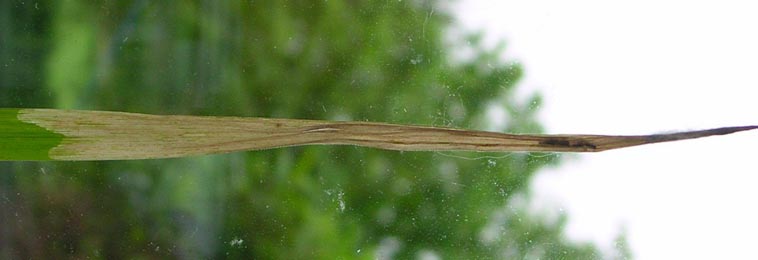|
||||||
|
KOELERIA. Hair-grasses. [Poaceae] |
|
Three species and subspecies of Koeleria are recorded in Britain. Six British miners are recorded on Koeleria. A key to the European miners recorded on Koeleria is provided in Bladmineerders van Europa. Nearly 100 British miners or possible miners are recorded on grasses in Britain. It is recommended that adults of all miners on grasses be reared to be certain of their identity. |
|
Key for the identification of the known mines of British |
1a > Leaf-miner and case-bearer: The larva lives outside the mine, protected by a case, and feeds on the underlying plant tissues via a hole cut in the epidermis. From that point it eats away as much leaf tissue as it can reach without fully entering the mine. Mine does not contain frass (Coleophora species) |
1b > Leaf-miner, but not a case-bearer: The larva lives mainly inside the mine. Mine usually contains frass. In later instars the larva may live sandwiched between two more or less circular sections cut from the leaf. |
2a > Leaf-miner and case-bearer: The young larva eats the receptacle out of a floret of Acinos arvensis, and uses the calyce as its first case. Even before the onset of winter it switches to grasses. The larva then lives in an ochraceous, bivalved, tubular leaf case of c. 9 mm, with a mouth angle of c. 25°. The case is illustrated in British Leafminers. |
|
Coleophora tricolor Walsingham, 1899 [ Lepidoptera: Coleophoridae]. |
2b > Seed-feeder, leaf-miner and case-bearer: Initially it feeds on the seeds of thyme and then uses the seedhead as a case. It overwinters in this case and starts feeding again in March on grass spp. It then makes a case from the mined blade of grass. The larva initially feeds on the seeds of thyme, feeding within a floret and using this as its case. After overwintering, it changes foodplants to grass, and eventually forms an elongated case from two grass blade portions sewn together. The larva begins its life by eating out the ripe fruit of a thyme floret. The emptied and dried calyx functions as its first case, in which it hibernates. After hibernation the larva switches to grasses, initially in its original thyme case. Later a new case is made out of a mined grass leaf. This final case is about 11 mm long, two-valved, straw-coloured, has a mouth angle of 25°, and bears a striking resemblance to a grass spikelet. |
|
Coleophora lixella Zeller, 1849 [Lepidoptera: Coleophoridae] |
3a > Leaf-miner: Narrow, flat gallery, descending from the tip of the leaf. |
|
Elachista collitella (Duponchel, 1843) [Lepidoptera: Elachistidae]. |
3b > Leaf-miner: The larva mines from the grass tip downwards and the mine occupies half or the whole of the leaf blade width. A whitish blotch is formed with characteristic narrow streaks of frass. Full depth blotch, slightly inflated, descending from the leaf tip, occupying half or the entire width of the blade. The larva may move and make a new mine elsewhere. In the latter case the mines are fairly short; otherwise an entire blade may be mined out. Frass in a some narrow greyish brown streaks. Pupation outside the mine. |
|
Elachista albifrontella (Hübner, 1817) [Lepidoptera: Elachistidae]. |
3c > Leaf-miner: In autumn the larva makes a narrow corridor a few cm in length, in which it hibernates. In March it moves to a new leaf. Here a transparent, full depth mine is made that descends from the leaf tip, and occupies the entire width of the blade. Most frass is concentrated in the oldest, highest, part of the mine. The larva may leave its mine and restart elsewhere. Pupation outside the mine |
 Mine of Elachista argentella on Dactylis glomerata Image: © Ben Smart (British leafminers) |
|
Elachista argentella (Clerck, 1759) [Lepidoptera: Elachistidae]. |
3d > Leaf-miner: The larvae mine the blades of various grasses, including meadow-grass and cock's-foot. Long, flat, whitish, relatively broad corridor descending from the leaf tip. Frass irregularly scattered. The larva may make several mines during its lifetime. Pupation outside the mine. |
|
Elachista freyerella (Hübner, 1825) [Lepidoptera: Elachistidae]. |
| Last updated 05-Jul-2019 Brian Pitkin | ||
